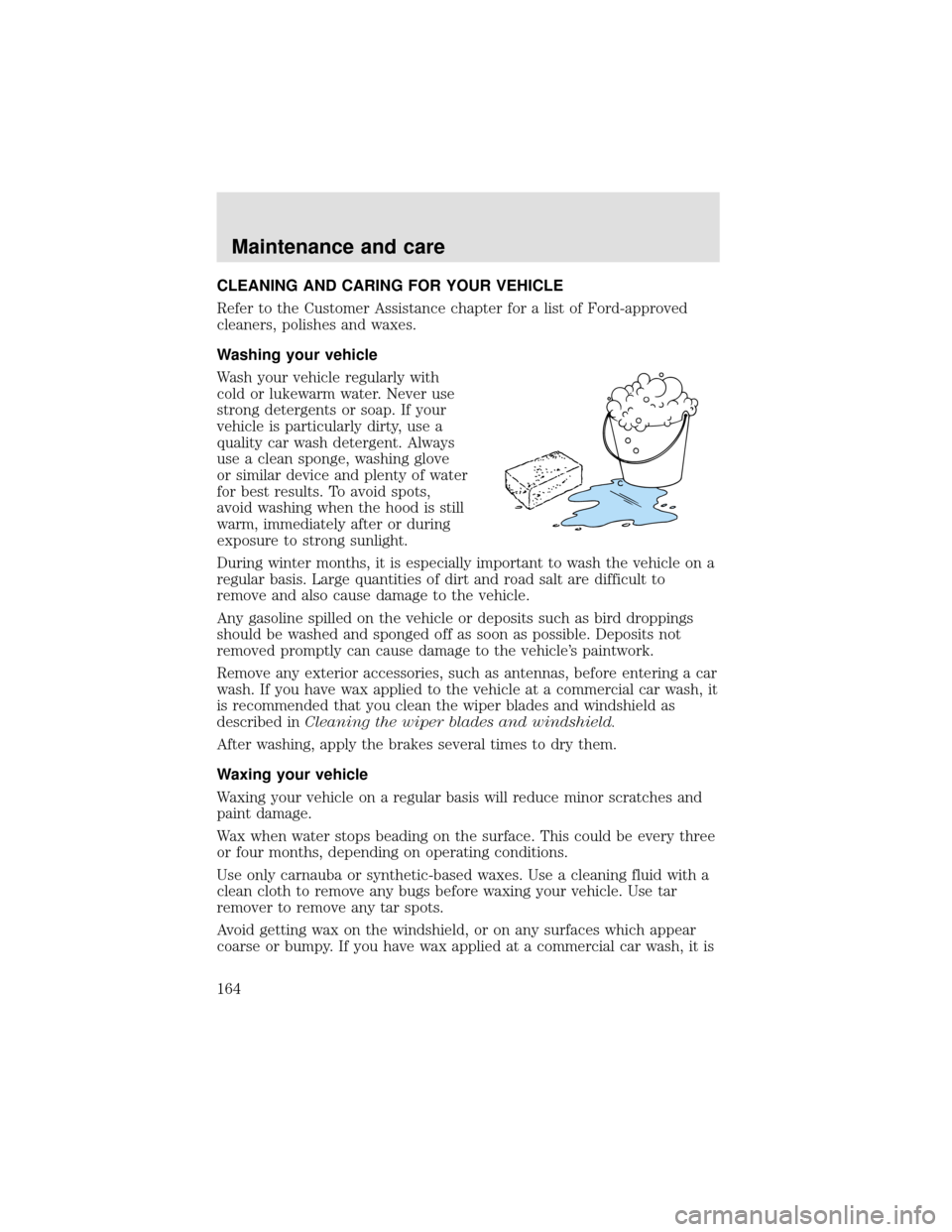2000 FORD F750 wiper blades
[x] Cancel search: wiper bladesPage 133 of 208

Use only a DOT 3 brake fluid designed to meet Ford specifications. Refer
toCapacities and specifications.
1. Set the parking brake, shift into 1
(First) and turn the engine off.
2. Open the hood.
3. Clean the reservoir cap before
removal to prevent dirt and water
from entering the reservoir.
4. Remove cap and rubber
diaphragm from reservoir.
5. Add fluid until the level reaches
the step in the reservoir.
6. Reinstall rubber diaphragm and cap onto reservoir.
WINDSHIELD WASHER FLUID
Checking and adding washer fluid
Inspect the solution level in the
washer reservoir when insufficient
solution is sprayed.
Use 3.8L (4.0 quarts) of
Ultra—Clear Windshield Washer
Concentrate or a washer fluid that
meets the Ford specification listed.
Refer toLubricant specifications
in theCapacities and
specificationschapter.
State or local regulations on volatile
organic compounds may restrict the use of methanol, a common
windshield washer antifreeze additive. Washer fluids containing
non-methanol antifreeze agents should be used only if they provide cold
weather protection without damaging the vehicle’s paint finish, wiper
blades or washer system.
Do not put engine coolant or antifreeze in the washer fluid
reservoir. Engine coolant or antifreeze can severely reduce
visibility if sprayed on the windshield.
Maintenance and care
133
Page 146 of 208

10. Reset the air filter restriction indicator.
11. Inspect the air induction system for loose fitting, damaged or missing
components and repair as necessary.
WINDSHIELD WIPER BLADES
Check the wiper blades at least twice a year or when they seem less
effective. Substances such as tree sap and some hot wax treatments used
by commercial car washes reduce the effectiveness of wiper blades.
Checking the wiper blades
If the wiper blades do not wipe properly, clean both the windshield and
wiper blades using undiluted windshield wiper solution or a mild
detergent. Rinse thoroughly with clean water. To avoid damaging the
blades, do not use fuel, kerosene, paint thinner or other solvents.
Changing the wiper blades
To replace the wiper blades:
1. Pull the wiper arm away from the
windshield and lock into the service
position.
2. Turn the blade at an angle from
the wiper arm. Push the lock pin
manually to release the blade and
pull the wiper blade down toward
the windshield to remove it from the
arm.
3. Attach the new wiper to the
wiper arm and press it into place
until a click is heard.
Maintenance and care
146
Page 164 of 208

CLEANING AND CARING FOR YOUR VEHICLE
Refer to the Customer Assistance chapter for a list of Ford-approved
cleaners, polishes and waxes.
Washing your vehicle
Wash your vehicle regularly with
cold or lukewarm water. Never use
strong detergents or soap. If your
vehicle is particularly dirty, use a
quality car wash detergent. Always
use a clean sponge, washing glove
or similar device and plenty of water
for best results. To avoid spots,
avoid washing when the hood is still
warm, immediately after or during
exposure to strong sunlight.
During winter months, it is especially important to wash the vehicle on a
regular basis. Large quantities of dirt and road salt are difficult to
remove and also cause damage to the vehicle.
Any gasoline spilled on the vehicle or deposits such as bird droppings
should be washed and sponged off as soon as possible. Deposits not
removed promptly can cause damage to the vehicle’s paintwork.
Remove any exterior accessories, such as antennas, before entering a car
wash. If you have wax applied to the vehicle at a commercial car wash, it
is recommended that you clean the wiper blades and windshield as
described inCleaning the wiper blades and windshield.
After washing, apply the brakes several times to dry them.
Waxing your vehicle
Waxing your vehicle on a regular basis will reduce minor scratches and
paint damage.
Wax when water stops beading on the surface. This could be every three
or four months, depending on operating conditions.
Use only carnauba or synthetic-based waxes. Use a cleaning fluid with a
clean cloth to remove any bugs before waxing your vehicle. Use tar
remover to remove any tar spots.
Avoid getting wax on the windshield, or on any surfaces which appear
coarse or bumpy. If you have wax applied at a commercial car wash, it is
Maintenance and care
164
Page 165 of 208

recommended that you clean the wiper blades and windshield as
described inCleaning the wiper blades and windshield.
Repairing paint chips
Minor scratches or paint damage from road debris may be repaired with
the Ultra Touch Prep and Finishing Kit (#F7AZ-19K507–BA), Lacquer
Touch-up Paint (#ALBZ-19500–XXXXA), or Exterior Acrylic Spray
Lacquer (#ALAZ-19500–XXXXA) from the Ford Car Care Chemicals line.
Please note that the part numbers (shown as XXXX above) will vary with
your vehicle’s specific coloring. Observe the application instructions on
the products.
Remove particles such as bird droppings, tree sap, insect remains, tar
spots, road salt and industrial fallout immediately.
Cleaning the wheels
Wash with the same detergent as the body of your vehicle. Do not use
acid-based or alcohol-based wheel cleaners, steel wool, fuel or strong
detergents. Never use abrasives that will damage the finish of special
wheel surfaces. Use a tar remover to remove grease and tar.
The brushes used in some automatic car washes may damage the finish
on your wheels. Before going to a car wash, find out if the brushes are
abrasive.
Cleaning the engine
Cover the underhood electrical connections and terminals of your vehicle
when cleaning the engine compartment. Avoid spraying or splashing
cleaning solvents or detergent solutions on the terminals and
connections. After the cleaning is completed and with the engine not
running, remove the protective cleaning coverings. Exposing electrical
connections and terminals to cleaning solvents and detergent solutions
over a period of time can corrode them and result in electrical system
damage and malfunctions.
Underbody
Flush the complete underside of vehicle frequently. Keep body drain
holes unplugged. Inspect for road damage.
Maintenance and care
165
Page 166 of 208

Cleaning non-painted plastic exterior parts
Use vinyl cleaner for routine cleaning. Clean with a tar remover if
necessary. Do not clean plastic parts with thinners, solvents or
petroleum-based cleaners.
Cleaning the exterior lamps
Wash with the same detergent as the exterior of your vehicle. If
necessary, use a tar remover such as Ford Extra Strength Tar and Road
Oil Remover (B7A-19520–AA).
To avoid scratching the lamps, do not use a dry paper towel, chemical
solvents or abrasive cleaners.
Cleaning the wiper blades, windshield and rear window
If the wiper blades do not wipe properly, clean the wiper blade rubber
element with undiluted windshield washer solution or a mild detergent.
To avoid damaging the blades, do not use fuel, kerosene, paint thinner or
other solvents.
If the wiper still does not wipe properly, this could be caused by
substances on the windshield or rear window such as tree sap and some
hot wax treatments used by commercial car washes. Clean the outside of
the windshield or rear window with a non-abrasive cleaner such as Ford
Ultra-Clear Spray Glass Cleaner, (E4AZ-19C507–AA), available from your
Ford Dealer.Do notuse abrasive cleansers on glass as they may cause
scratches. The windshield or rear window is clean if beads do not form
when you rinse it with water. The windshield, rear window and wiper
blades should be cleaned on a regular basis, and blades or rubber
elements replaced when worn.
Cleaning the instrument panel
Clean with a damp cloth, then dry with a dry cloth.
Avoid cleaner or polish that increases the gloss of the upper portion of
the instrument panel. The dull finish in this area helps protect the driver
from undesirable windshield reflection.
Do not use chemical solvents or strong detergents when cleaning
the steering wheel or instrument panel to avoid contamination of
the air bag system.
Maintenance and care
166
Page 187 of 208

Maintenance Operation Frequency — ObservationClean body/door drain holes.
Clean windshield wiper blades.
Replace windshield wiper blades.
Lubricate body lock cylinders, door and hood hinges.
Check headlamp alignment.
Check windshield washer fluid level. Add fluid if required.At least twice annually.
As required.
If wiping the blades with a clean cloth and mild detergent
and washing the windshield with a cleaner does not restore
a clean wipe.
Difficult to operate or noisy.
Lamp beams in wrong position when vehicle operating
loaded.
If washers do not spray fluid when operated. GENERAL MAINTENANCE SERVICES
Listed below are vehicle checks that should be made periodically either by the owner or a qualified technician. It is recommended
that deficiencies be brought to the attention of your dealer or another qualified service outlet as soon as possible in order that
advice regarding the need for service or replacement can be obtained.
General maintenance information
187
Page 205 of 208

Air cleaner filter .......................142
Air conditioning ..........................21
Audio system (see Radio) .........26
Automatic transmission ............102
Auxiliary power point .................21
Battery .......................................140
jumping a disabled battery ....125
voltage gauge ............................18
Belt minder .................................67
Brakes ................................82,84,87
anti-lock ......................82,83,84,90
anti-lock brake system
(ABS) warning light ............12,83
brake warning light .............10,11
fluid, checking and adding ....131
parking ............................85,87,90
trailer .........................................93
Child safety restraints ................71
child safety belts ......................71
Child safety seats ...................72,73
attaching with tether straps ....75
in front seat ..............................74
in rear seat ................................74
tether anchorage hardware .....76
Cleaning your vehicle ...............164
engine compartment ..............165
exterior ....................................165
exterior lamps .........................166
instrument panel ....................166
instrument panel lens ............167
interior .....................................167
plastic parts ............................166
safety belts ..............................167
washing ....................................164
waxing .....................................164
wheels ......................................165
wiper blades ............................166
Climate control (see Air
conditioning or Heating) ............21
Clock ..................................29,36,45
Clutch ........................................132
fluid ..........................................132Coolant ......................................134
checking and adding ..............134
Cruise control
(see Speed control) ....................51
Customer Assistance ................114
Ford accessories
for your vehicle ......................201
Ford Extended
Service Plan ............................194
Getting assistance outside
the U.S. and Canada ..............200
Getting roadside assistance ...114
Getting the
service you need ....................194
Ordering additional
owner’s literature ...................203
The Dispute
Settlement Board ...................197
Utilizing the Mediation/
Arbitration Program ...............200
Daytime running lamps
(see Lamps) ................................20
Driving under special
conditions
through water .........................112
Emergencies, roadside
jump-starting ..........................125
Emission control system ..........176
Engine
check engine/
service engine soon light .........14
cleaning ...................................165
coolant .....................................134
Engine block heater ...................80
Engine fan .................................136
Engine oil ..................................127
checking and adding ..............127
oil pressure gauge ....................19
recommendations ...................129
Exhaust fumes ............................81
Fuel ............................................151
Index
205
Page 207 of 208

Relays ........................................115
Safety belts
(see Safety restraints) .....61,62,63
Safety defects, reporting ..........204
Safety restraints ................61,62,63
belt minder ...............................67
cleaning the safety belts ...70,167
extension assembly ..................66
for adults ..............................62,63
for children ...............................71
lap belt ......................................65
warning light
and chime ........................14,15,66
Safety seats for children .......72,73
Seat belts
(see Safety restraints) ...............61
Seats ............................................58
child safety seats .................72,73
Servicing your vehicle ..............179
Speed control ..............................51
Speedometer ...............................17
Starting your vehicle ..................77
jump starting ..........................125
preparing to start your
vehicle .......................................77
Tachometer .................................18
Tires
checking the pressure ............151Towing
wrecker ....................................125
Transmission
fluid, checking and adding
(automatic) .............................137
fluid, checking and adding
(manual) .................................137
manual operation ......................97
Trip odometer .............................18
Turn signal .............................12,49
Vehicle Identification
Number (VIN) ...........................173
Vehicle loading ..........................111
Warning chimes ......................10,15
Warning lights (see Lights) .......10
Washer fluid ..............................133
reservoir ..................................133
Water, Driving through .............112
Wheels .......................................147
Windows
power .........................................55
Windshield washer
fluid and wipers
checking and cleaning ............146
operation ...................................50
replacing wiper blades ...........146
Wrecker towing .........................125
Index
207